Caesarea National Park is a coastal city in northern Israel, famous for its ancient Hellenistic ruins of an ancient Roman city.
Located between Tel Aviv and Haifa, Caesarea is one of my favorite tourist attractions in Israel!
Just about every time friends come to visit and ask me to show them around, this is one of the places i bring them.
Especially for Americans whose local history is relatively young, I think there is something so special about walking around the ancient city in which you can see how people lived.
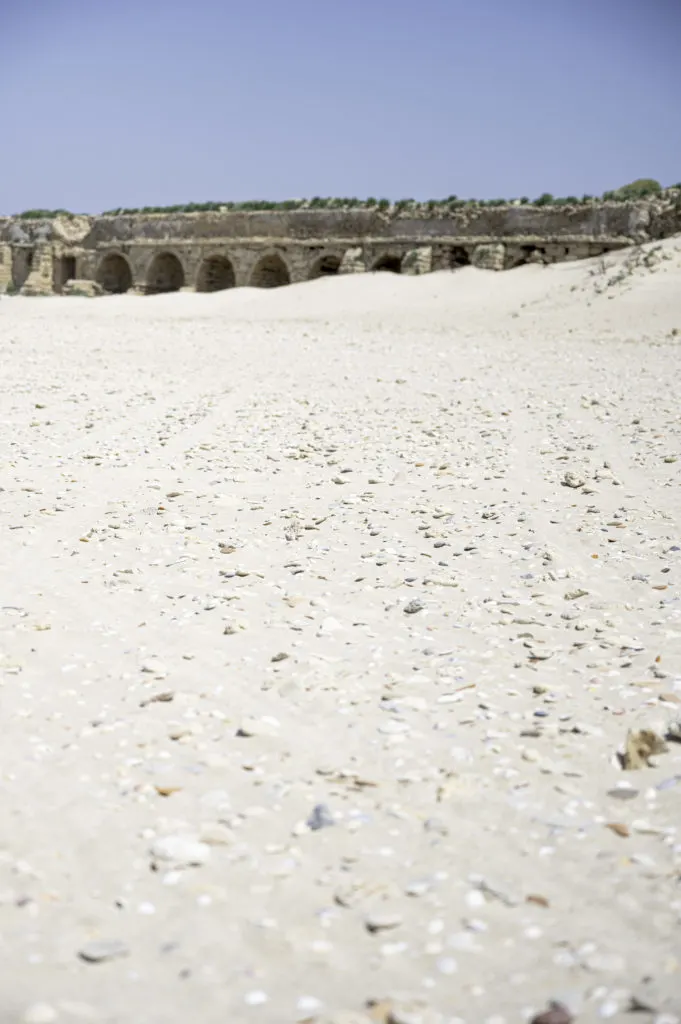
Sure, the city isn’t what it once was, and it has been built on throughout the centuries, but I think it’s like getting a peek into history, and with a little imagination, you get the picture.
In the photo above, you can see the Ancient Roman aqueduct, and the little orange pieces on the beach are broken off ancient clay roof tiles.
Most of what is worth seeing in Caesarea is located in Caesarea National Park. However, even the map given to you with your tickets marks nearby sites which are outside of the park.
With this in mind, I included all nearby sites marked on the map as well as those that aren’t. Only sites mentioned up until the Temple Platform are actually in the park.
History of Caesarea
During the Persian rule, the Phoenicians built a settlement on the shoreline of one of the bays where the ground water level was high.
The settlement is mentioned in the Ancient Egyptian Zenon Papyri under the name Straton’s Tower (in Hebrew – Migdal Sharshon), after its founder, the King of Sidon.
It was part of the line of settlements established from Tyre and Sidon along the coastline, down to Egypt.
In 103 BCE, nearby, Dor (now Tel Dor) and Straton’s Tower were conquered by Alexander Janneus, annexed by the Hasmonean Kingdom, and torn away from it after the Roman conquest.
In the Roman period, Herod identified its potential, and in 30 BCE it was awarded to him by the Romans, and he built a port city there.
According to Josephus, the town was forsaken and Herod chose it because its location was suitable to “carry out his ambitious plans.” Josephus goes on to say that Herod rebuilt the area entirely of white stone and built a royal palace of “unique splendor.”
He named it Caesarea, in honor of Augustus Caesar, who gifted the territory to Herod.
Get it? Caesar – so Caesarea? It seriously took me too long to figure that out.
Previous port cities at that time were established in the vicinity of natural bays, but Herod built one of the largest and the most sophisticated ports in the Middle East.
Caesarea was a planned city, with a network of roads, a temple, theatre, amphitheater, market, and residential quarters. It took 12 years to build, and great festivities were held to mark its completion.
The city quickly grew into a great commercial center, and by the year 6 BCE, it became the headquarters of the Roman government.
Caesarea was at the peek of its prosperity in the Roman-Byzantine period.
Its population included Jews and pagans and conflicts between them was an important cause of the Great Revolt that erupted in 66 BCE.
Caesarea served as a base for the Roman legions who dealt with the quelling of the revolt. In fact, it was here that their commanding general Vespasian was declared Caesar.
The city received the status of “colony” in the Roman Empire. After Herod’s death and burial at Heroduim, the Romans moved the capital from Jerusalem to Caesarea.
Then, after the fall and destruction of Jerusalem, it became the most important city in the country.
Being the center of the quelling of the Bar Kochva revolt, this is likely where the Jewish leaders headed by Rabbi Akiva were tortured to death.
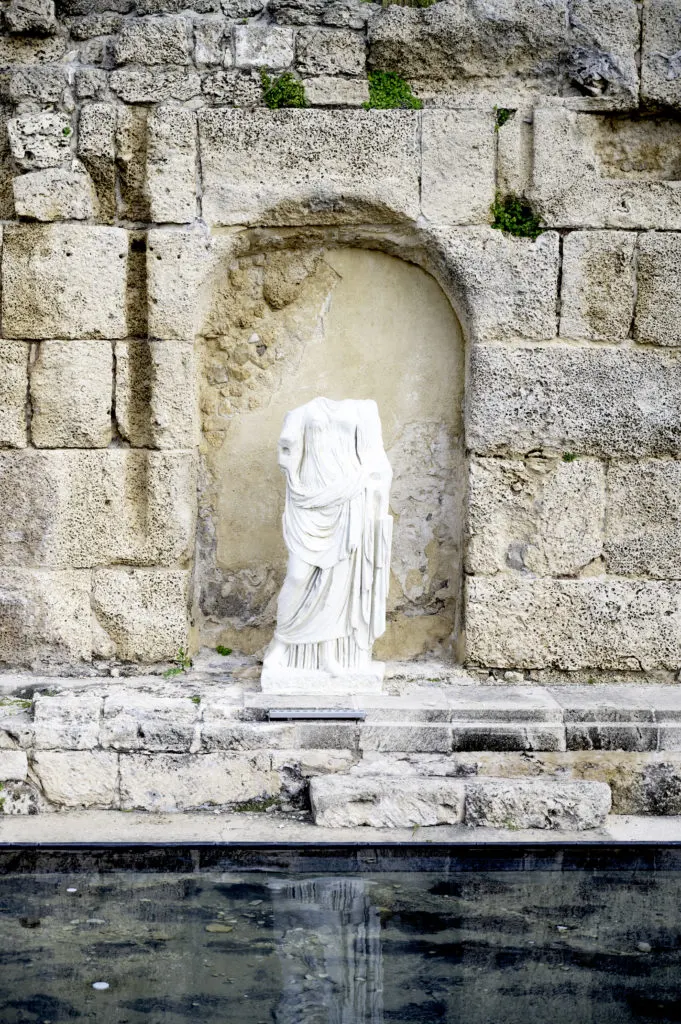
The population in the city was mixed, and the lifestyle was completely foreign to the Land of Israel. Pagans, Samaritans, Jews, and Christians lived in Caesarea in the 3rd and 4th centuries CE.
At this point in time, Caesarea was a major port city and an important cross-road. Trading ships anchored there for replenishment, rest, and repairs.
During the Byzantine period, the city became a large metropolis, and enjoyed an important status due to the Christian community living there. Towards the end of the 5th century CE, a perimeter wall was built, making Caesarea the largest fortified city in the country.
After the Arab conquest, Caesarea lost its political and economic significance. Most of its citizens left the city, and it became a small forsaken village.
It was only in the 9th century, with the development of sea-trade did the coastal city experience some recovery.
Crusaders took the city in 1101 and a small port was built on the ruins of the old port that suited the city they had established.
Caesarea was temporarily captured by Saladin in 1187, but was retaken by Richard the Lion Heart a few years later.
Fun fact, if you look along the beachside of the port, you can see a section where Roman pillars are visible within the walls. These were used for filler by Crusaders when the wall was built.
It was fortified with a thick wall surrounded by a moat that you can still cross today and enter the restored Crusader city.
Then, in 1251, Caesarea was fortified anew with impressive intensity. However, only 14 years later it was conquered by the Mamelukes.
The Mamelukes feared the return of the Crusaders, so they methodically destroyed the coastal cities and ports. Caesarea was lost under the ruins and deserted.
The city remained desolate for centuries, and its ruins became a source of lime and building stone for the region.
In the late 1800s, when the Ottoman authorities settled Bosnian refugees in Caesarea, the destroyed Crusader fortress was renovated and became the administrative center with new homes built on the ruins.
In 1873, a survey of the ruins was the first scientific exploration of the site.
They noted the Crusader city, the theater, hippodrome, and aqueducts.
Archaeological finds such as columns, pillars, statues, and inscriptions were uncovered and removed from the site.
Since 1947, only limited digs were carried out until extensive explorations began in 1959 until 1964.
It revealed the theater, parts of the city’s fortifications, the upper aqueduct, parts of the Crusader city, and the Jewish quarter.
Following the excavation, the Crusader city and theater became a national park. Since then, many excavations have been carried out in the city and its harbor.
What to see
There is lots to see in Caesarea from the ruins to local museums. Following is some of what there is to see in and around Caesarea National Park.
Caesarea Harbor Visitors’ Center
After five years of excavation, conservation, and development, the Caesarea Harbor Visitors’ Center was established right inside the restored harbor vaults.
The huge vaults were erected by Herod as part of the storage system in the harbor and served as the basis for the temple stage.
Four of the fourteen vaults have been restored and filled with fascinating content. Each of the four restored vaults provides a glimpse into Caesarea throughout history.
The theater
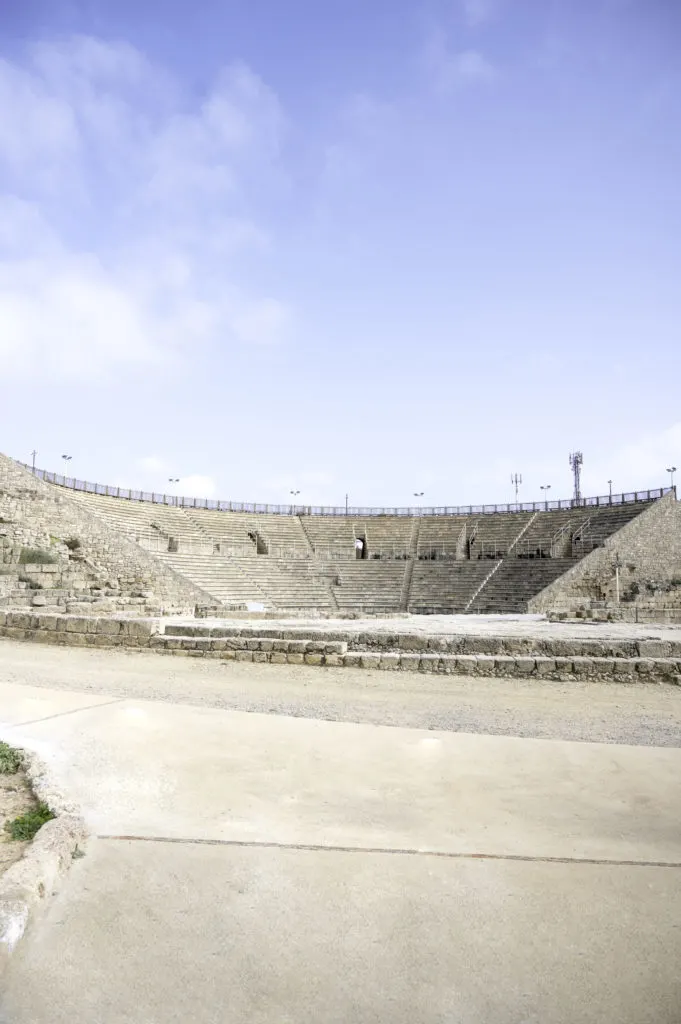
This theater is the most ancient of all the theaters found in Israel. While it was built in Herod’s time, it continued to be used for hundreds of years.
The theater was built by Emperor Vespasian, using Roman arch-based technology. At a later stage, King Herod added a few more blocks of seats and enlarged it, and it was able to hold 4,000 spectators.
Behind the stage was a three story high wall, built with tall pillars, which served as the stage background.
The shape of the theater was influenced by the classic model of Roman theaters and faces the sea. The semi-circular floor of the orchestra, first paved in painted plaster, was later paved with marble.
People from the highest and lowest walks of life came here to enjoy dramas and comedies.
The well-known term “bread and amusement” originates from the tradition established by Augustus Caesar, after whom the city of Caesarea is named.
Being a port city, which hosted sailors and seamen, it was important to provide them with places of entertainment in order to encourage them to return to the city.
Towards the end of the Byzantine period, the theater was converted into a castle and was deserted after the Arab conquest.
Today, it is possible to see here some of the original seats as well as marble decorations from the 2nd century CE. The theater was destroyed in the 3rd century. Nothing is left of the scaenae frons.
What remains of the theater is still in use today, hosting some of Israel’s top artists and performers.
The Reef Palace AKA Promontory palace
The Reef Palace is a large courtyard with pillars facing the sea. It was once an impressive palace dating back to the Roman and Byzantine periods.
This was the inner courtyard of the guest wing of the place and consisted of two stories for guests and residents.
Although Herod was never in Caesarea, some researchers attribute the palace to him, and they assume that it was one more of his splendid buildings.
Others argue that the palace may even not have been built in Herod’s day. Since Herod was naturally suspicious, they doubt he would have built a private palace in such proximity to public buildings.
It is possible that it was governors who came to the city after the time of Herod’s reign lived in the palace because they preferred the dynamic life in Caesarea over Jerusalem.
The palace has a pool which archaeologists believe once served as the city’s fish market.
The palace fell into ruin over the years and very little is left of it.
On the reef, there are the remains of a swimming pool in the sea. A mosaic floor was also found alongside the pool, as well as a ritual bath (Mikveh) from the late Roman period.
Herodian Amphitheater
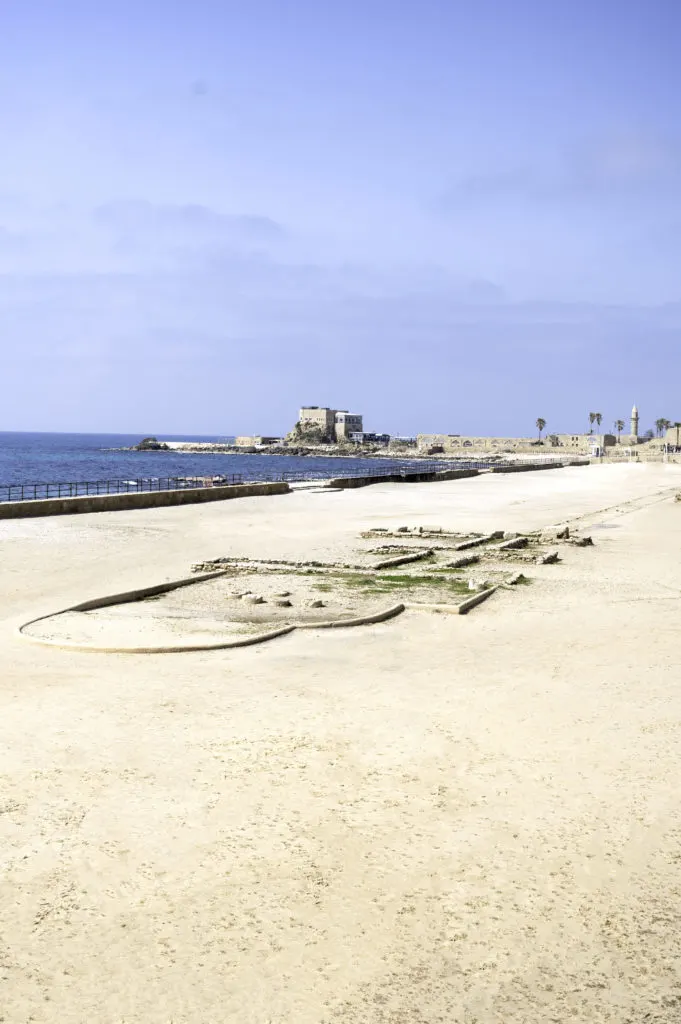
The amphitheater is a huge U-shaped entertainment structure. It was built by Herod and was probably used for horse racing, sport events, and entertainment shows during the Roman period.
It was complete with an arena which could seat 10,000 spectators and in the first century CE seating areas were added, increasing its capacity to 15,000.
During the second century, the amphitheater was rebuilt and adapted for use as a more standard type of amphitheater.
The Bathhouse
Remains of several large buildings were exposed, among them an elaborate 4th century renovated bathhouse.
It was a luxurious public bathhouse which occupies more than half the area. It appears to have been built after Herod’s amphitheater ceased to function.
It consisted of groups of courtyards and rooms with benches along the walls.
Most of them were paved with mosaics and in the caldarium (hot-room) area were several rooms with a heating system.
Some particularly elegant rooms were paved in marble and had mosaic decorations on the walls. One depicts a female with the words “pretty woman” next to it.
Before bathers entered the bathhouses, they would enter the Pilaster, where they would exercise.
After immersing in the bathhouses, the bathers would again enter the Pilaster to receive massages.
Commercial and Administrative Area
Built near the amphitheater, the commercial area was erected on vaults, which served as warehouses. One of the vaulted chambers was used as a sanctuary of the god Mithras.
Roman Mosaic
A rare, colorful mosaic dating from the 2nd-3rd century CE was uncovered near a Crusader bridge.
It contains the image of three male figures wearing togas, geometric patterns, as well as a largely damaged inscription in Greek.
Archaeological Park
The Archaeological Park displays archaeological items that were found all over the park with explanations.
Fortified Medieval City
In the 9th century, a fortified city surrounded the harbor.
The walls were later incorporated into the fortifications of Louis IX, which consisted of a high perimeter wall and a 9 meter or 30 feet deep dry moat.
The wall included gates in the north, east, and south with several secret gateways called posterns.
There was also a harbor fortress which was separated from the city by a trench filled with sea water.
The Crusader gate is part of fortifications and is one of the entrances to Caesarea National park.
If you stand inside the gate and look upward, you can see a cross-shaped stone at the center of the arch.
The Port and Harbor
A large artificial harbor was built during the time of Herod. It was the first quay-based port of its kind in the Middle East. Up until then, the coastal ports relied on natural marinas.
It consisted of an outer quay with a 400 meter long breakwater, an inner quay, and an anchorage area, along which stood columns and mooring stones.
Ships carrying grain departing from Egypt to Rome – which fed the city – needed a place for anchorage and rest, for re-stocking and repairs, as well as a safe haven in stormy weather.
The port city became a kind of window on distant cultures, since goods from the entire Mediterranean basin entered and departed through it.
The breakwater sank and collapsed during the Roman period, but it was repaired in the Byzantine period.
The port ceased to function towards the end of the Byzantine period, when the quays collapsed due to a lack of engineering knowledge, despite rehabilitation efforts.
After the Arab conquest, the harbor fell into disuse but was restored once again in the 9th century.
During the Crusader period, a new breakwater was built, with columns taken from the ruins of Byzantine Caesarea.
The inner basin, which had been clogged with silt, became a residential quarter.
The finished dock you can see there today is modern and was built after the creation State of Israel.
The majority are architectural elements such as pillars and capitals, gravestones, sculptures, etc.
I particularly enjoy the sarcophagus with Medusa’s head carved into it!
The delicate carvings, the careful chiseling, and the excellent artisanship are evidence of the city’s luxury.
It is one of the few extant examples of mosaics from that specific time period in Israel.
Today, the region of the port around which the Crusader city was built is home to cafes and restaurants which were established in the ancient buildings, as well as galleries displaying Israeli art.
The Temple Platform
In Herod’s time, an elevated platform was built here to serve as a base for a lavish temple dedicated to Roma and his patron, Emperor Augustus.
During the Byzantine period, an octagonal church was erected on the site.
Then, after the Arab conquest, a mosque was stood in its place.
Later still, the Crusader cathedral was built in the exact same location.
The Synagogue
This is thought to have been the Jewish quarter of Caesarea throughout the Roman and Byzantine periods.
Remains of a Byzantine 5th century synagogue were found on the seashore north of the harbor and faces towards Jerusalem.
Architectural details were found in its ruins, including capitals with carved menoras, a column inscribed shalom, and parts of a Hebrew inscription listing the twenty-four priestly courses in the Temple in Jerusalem.
The largest remains are the mosaic floor and broken fragments of a grille listing the 24 priestly courses, which were unearthed here.
The synagogue is mentioned in Josephus’ book: The Jewish War.
According to the writing, this was the site where the fire that burned all of Judea in the revolt against the Romans was started.
Many Jews lived in Caesarea during the Roman period.
Though it appears that there were many conflicts with the foreign neighbors in the city, there is also evidence of good neighborly relations.
The Roman Wall
Ruins of Roman Caesarea’s fortifications were excavated in the northwestern city limits.
They include parts of a wall, a rectangular tower, and a round-towered gate. A paved street with a sewage tunnel beneath it ran through the gate.
This part of the wall was probably built on top of the ancient fortifications of Straton’s Tower, the Phoenician village which predated Caesarea.
The Amphitheater
The remains of an oval Roman amphitheater, which probably dates to the 2nd century CE, were uncovered.
The amphitheater was used for gladiatorial and animal combats.
Byzantine Wall
A perimeter wall over 2,600 meters, or over 1.5 miles, long surrounded Byzantine Caesarea.
It had several gates and square towers.
Its southern gate was discovered on the grounds of Kibbutz Sedot Yam.
Hippodrome
The hippodrome was built in the 2nd century for chariot racing and replaced Herod’s amphitheater. It was 450 meters (1,476 feet) long and 90 meters (295 feet) wide. It could seat about 30,000 spectators.
Columns originally set on the wall running along the middle of the race track were unearthed in the area.
Also unearthed was a 27 meter (88.5 feet) high red granite obelisk which was erected in the hippodrome. It is the only one of its kind known to exist within Israel.
The obelisk, which originated in Egypt, was adopted by the Romans, who made it a common and fashionable addition to buildings that hosted chariot races.
Due to the importance and uniqueness of the obelisk, it was decided to re-erect the monument in its original location.
The obelisk was discovered broken in three sections. It was restored and reerected in 2001.
The Aqueduct
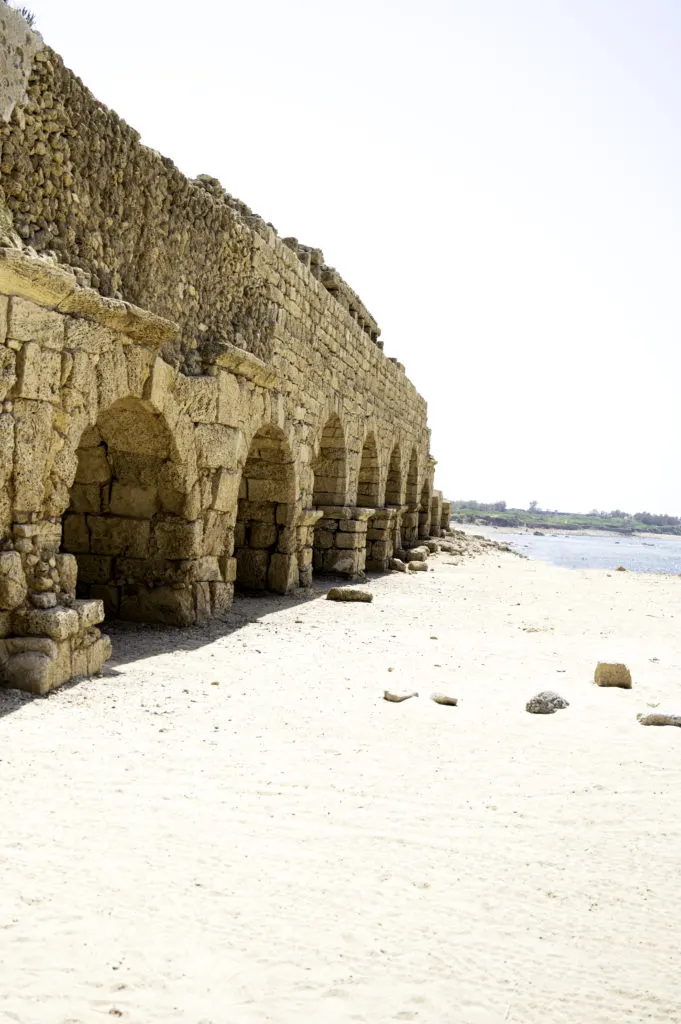
The Aqueduct, which provided an abundant supply of water, was built in the Herodian period and was later enlarged to a double channel when the city grew.
The upper aqueduct begins at the springs located some nine kilometers northeast of Caesarea, at the foot of Mount Carmel.
In some portions, the aqueduct was supported by rows of arches.
Entering the city, the water flowed through a network of pipes to collecting pools and fountains throughout the city.
Birds Mosaic
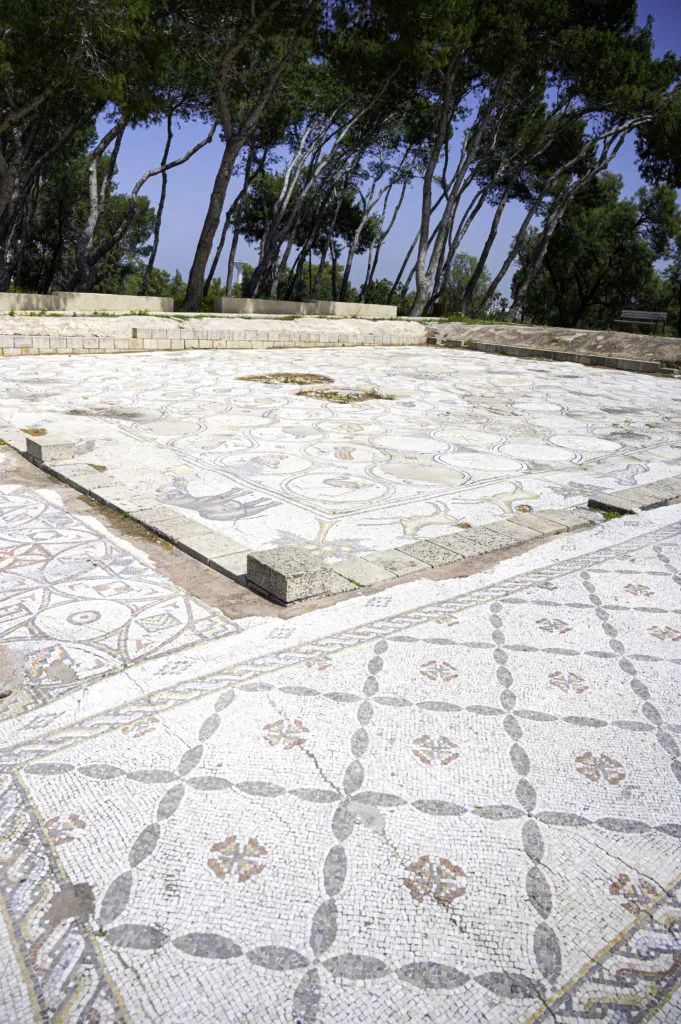
The Birds Mosaic was once the floor of a Byzantine palace that was built in the end of the 6th century or beginning of the 7th century.
The floor covered the central courtyard of the palace, which was led to by a portico on the west side. Surrounding it was a colonnade, rooms, and additional courtyards with mosaic floors.
It belonged to an unidentified wealthy Christian family, and the palace was destroyed by fire, apparently during the Arab conquest in 640.
The mosaic was discovered in 1950 during a military exercise.
At first, it was believed to be a church due to the apse located in the east of the building. However, since no pillars were found, it was proposed that it was roofless. Later, it was concluded that it was actually the central part of a villa.
The mosaic was recovered in 1955 to protect it, but in 2004, it was restored and strengthened for visitors.
The Birds Mosaic has a frame decorated with fruit trees bearing large beautiful fruit with native animals standing between the trees. Depicted are lions, leopards, bears, ibex, dogs, elephants, gazelle, oxen, wild boar, horse, and goat.
In the center of the mosaic are 120 round medallions populated by large colorful birds, which give the mosaic its name. The birds depicted are peacocks, storks, pelicans, herons, pheasants, grey-headed swamphen, duck, flamingo, guineafowl, ostrich, and rock partridge.
In the northwest corner of the site was a reservoir which received its water from a well. The complex was too high to receive water from Caesarea’s aqueduct, so it needed an independent water supply.
Visit Caesarea
See the Caesarea website for visiting hours and ticket prices.
There are cultural events on weekends, festivals, and holidays.
This includes folklore, equestrian displays (Pesach), street plays on ancient Caesarea (Succot), Olympic Games in the spirit of the period (Purim), and more.